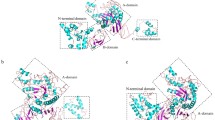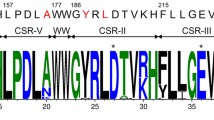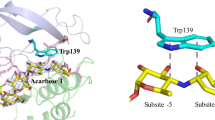Abstract
The calcium-binding residues, Tyr302 and His235, and the sodium-binding residue, Asp194, on the activity of Bacillus licheniformis α-amylase were investigated using site-directed mutagenesis. Tyr302 and His235 were replaced by Asn and Asp, respectively, to produce the mutants Y302N and H235D; Asp194 was replaced by Ala to produce D194A. The mutant amylases were purified to homogeneity; each was ~53 kDa. The specific activity of the D194A was 236 U mg−1, lower than the specific activity of the wild-type enzyme by 55%. No significant changes of thermostability, optimum temperature, and optimum pH level were observed in D194A. Mutant amylases with H235D and Y302N significantly improved their specific activity by 43% (754 U mg−1) and 7% (563 U mg−1), respectively, compared with the wild-type enzyme. H235D substitution decreased its optimum pH by approx. 0.5–1 pH unit.



Similar content being viewed by others
References
Brzozowski AM, Lawson DM, Turkenburg JP, Bisgaard-Frantzen H, Svendsen A, Borchert TV, Dauter Z, Wilson KS, Davies GJ (2000) Structural analysis of a chimeric bacterial alpha-amylase high-resolution analysis of native and ligand complexes. Biochemistry 39:9099–9107
Chi MC, Chen YH, Wu TJ, Lin LL (2010) Engineering of a truncated α-amylase of Bacillus sp. strain TS-23 for the simultaneous improvement of thermal and oxidative stabilities. J Biosci Bioeng 109:531–538
Declerck N, Machius M, Wiegand G, Huber R, Gaillardin C (2000) Probing structural determinants specifying high thermostability in Bacillus licheniformis α-amylase. J Mol Biol 301:1041–1057
Lim JK, Lee HS, Kim YJ, Bae SS, Jeon JH, Kang SG, Lee JH (2007) Critical factors to high thermostability of an alpha-amylase from hyperthermophilic archaeon thermococcus onnurineus NA1. J Microbiol Biotechnol 17:1242–1248
Liu Y, Shen W, Shi GY (2010) Role of the calcium-binding residues Asp231, Asp233, and Asp438 in alpha-amylase of Bacillus amyloliquefaciens as revealed by mutational analysis. Curr Microbiol 60:162–166
Lu T (2009) Seeking new mutation clues from Bacillus licheniformis amylase by molecular dynamics simulations. Chem Phys Lett 477:202–206
Machius M, Machius N, Huber R, Wiegand G (1998) Activation of Bacillus licheniformis α-amylase through a disorder → order transition of the substrate-binding site mediated by a calcium–sodium–calcium metal triad. Struct Chem 6:281–292
Nielsen JE, Borchert TV (2000) Protein engineering of bacterial α-amylases. BBA Protein Struct Mol Enzymol 1543:253–274
Priyadharshini R, Gunasekaran P (2007) Site-directed mutagenesis of the calcium-binding site of a-amylase of Bacillus licheniformis. Biotechnol Lett 29:1493–1499
Ramachandran S, Patel AK, Nampoothiri KM, Francis F, Nagy V, Szakacs G, Pandey A (2004) Coconut oil cake—a potential raw material for the production of α-amylase. Bioresour Technol 93:169–174
Shewale SD, Pandit AB (2007) Hydrolysis of soluble starch using Bacillus licheniformis a-amylase immobilized on superporous CELBEADS. Carbohydr Res 342:997–1008
Tanaka A, Hoshino E (2003) Secondary calcium-binding parameter of Bacillus amyloliquefaciens alpha-amylase obtained from inhibition kinetics. J Biosci Bioeng 96:262–267
Voskuil MI, Chambliss GH (1993) Rapid isolation and sequencing of purified plasmid DNA from Bacillus subtilis. Appl Environ Microbiol 59:1138–1142
Xiao ZZ, Storms R, Tsang A (2006) A quantitative starch-iodine method for measuring alpha-amylase and glucoamylase activities. Anal Biochem 351:146–148
Acknowledgments
We thank the staff of Jilin University and the Key Laboratory of Zoonosis Research, Ministry of Education, for the use of their facilities.
Author information
Authors and Affiliations
Corresponding author
Additional information
Yanan Qin and Zhen Fang equally contributed to this research as co-first authors.
Electronic supplementary material
Below is the link to the electronic supplementary material.
Rights and permissions
About this article
Cite this article
Qin, Y., Fang, Z., Pan, F. et al. Significance of Tyr302, His235 and Asp194 in the α-amylase from Bacillus licheniformis . Biotechnol Lett 34, 895–899 (2012). https://doi.org/10.1007/s10529-011-0843-x
Received:
Accepted:
Published:
Issue Date:
DOI: https://doi.org/10.1007/s10529-011-0843-x




